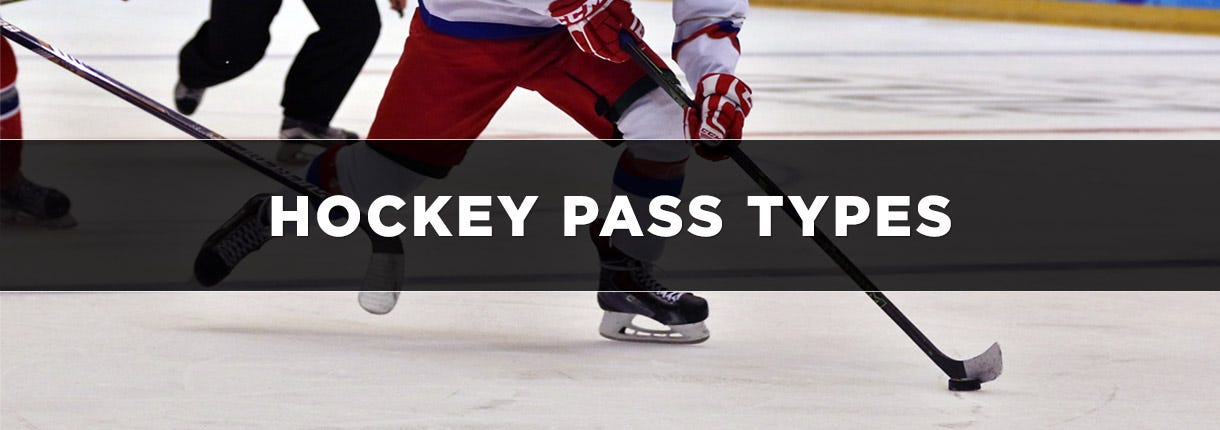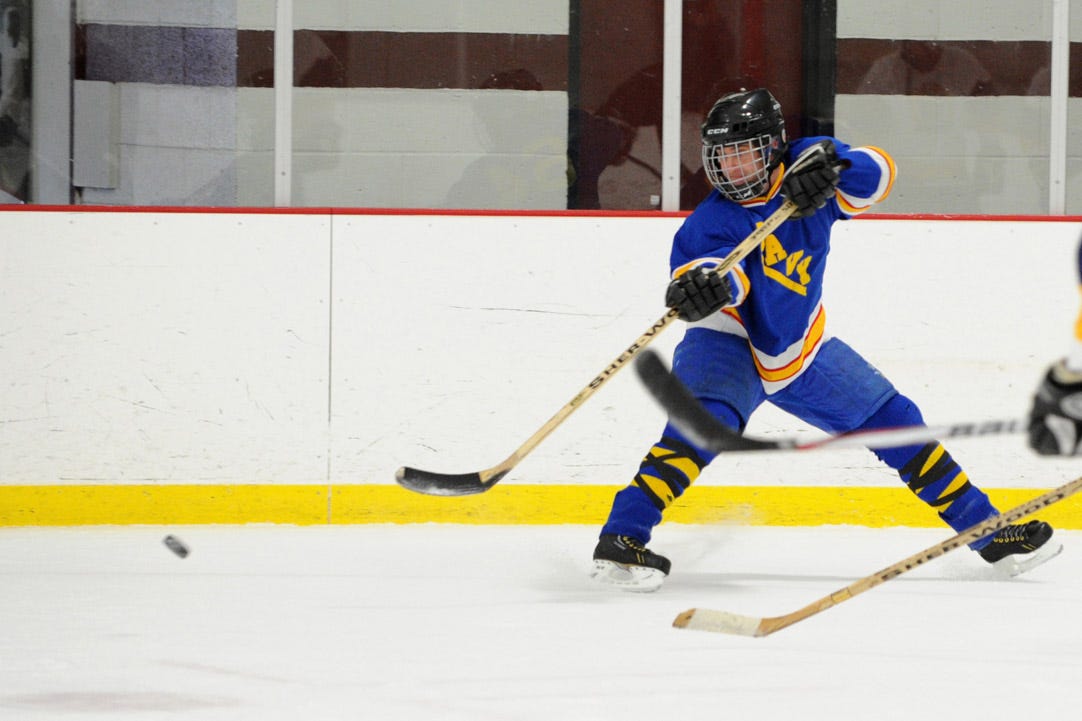Hockey Pass Types & How to Use Them | Hockey Monkey

Hockey Passes are one of the most important aspects within the game of ice hockey. Both good and bad hockey passes can have many different factors on the game, like leading to the game winning goal, or a turnover and a goal for the other team, so making good passes is crucial for any ice hockey team. Depending on which situation you are in, there are a wide variety of different types of passes you can utilize to create a scoring opportunity. Visit our website to shop a wide variety of hockey sticks, hockey pucks, and hockey blades!
How to Pass in Hockey
Step 1: Control puck on stick blade
Get the puck onto your stick blade and make sure that it is laying flat on the ice before you make your pass. Following this, keep your head up and look for an open teammate up the ice. From here, you will want to face the intended target, or their general direction.
Step 2: Puck Release
Once you find an open teammate, use your forearm strength to send the puck to its intended target. As you release the puck off your blade, quickly rotate your top wrist forward to help cup the puck. Doing this will help the puck on the ice, rather than fluttering off the blade.
Step 3: Following Through
On the follow-through of the pass, point your stick blade to where you want the puck to go, but without lifting the blade too far off the ice. When aiming, a general rule of thumb is to always pass to where the player is going. If the player you are passing to is skating forward, you will want to lead them with a pass so they can continue their forward momentum.
Types of Hockey Passes
There are a wide range of passes that a player can utilize during a game of ice hockey. The list below will discuss some of the commonly used ones, along with the general guidelines of how to perform them.
Saucer Pass

When executed correctly, the Saucer Pass resembles a flying saucer, hence the name! The Saucer Pass is an airborne pass from one teammate to another and is utilized many times throughout the course of a hockey game. Times where Saucer Passes are especially effective are for passes across the slot of the ice, since there are usually a lot of sticks within passing lanes in this area, looking to intercept the puck.
While they are a useful tool, Saucer Passes can take some practice to master. Unlike standard passes, you will want to open up the face of your blade a little bit. From there, start with the puck on the heel of your blade, and using a quick “sweeping” motion, you will quickly chip the puck off the toe of the blade.
Backhand Pass
A backhand pass is a pass that is made using the back side of the stick blade. This is another pass type that is used numerous times throughout the course of a hockey game and can be a very effective one to master. You will most commonly see this pass being used by the off-side winger to make a pass across the slot to a teammate. For example, if a left-handed player is skating on the right side of the ice, they will make a backhand pass across the ice to a teammate.
When making a backhand pass, you will want to start with the puck on the toe of your stick blade. From there, pull the puck back so it is just past your back foot (the one further away from the intended target). As you begin the pass, slightly cup the puck with the toe, and sweep the puck across your body. Follow through and point your stick blade at the intended recipient!
Drop Pass
Although used less frequently, a Drop Pass can be very effective if done correctly. A Drop Pass is when a player skating with the puck will pass to a teammate (usually a backhand pass between his own legs) and continues skating. The trailing teammate will then quickly recover the puck and go in for a shot on net.
If executed perfectly, this can be very deceptive for goalies since they will lose sight of the puck. This can also be a great way for the player receiving the pass to get an uncontested shot on net, due to the defender having to stay with the player who made the initial pass. As a downside, if not executed well, this could lead to a turnover and an odd-man rush for the opposing team.
Suicide Pass
A Suicide Pass is one that players always try to avoid, although unfortunately, they do happen from time to time. A Suicide Pass is when a player passes a puck to a teammate who appears to be open in a high-traffic area. This typically occurs when a defenseman is breaking out of their defensive zone and sees a winger cutting towards the middle of the ice. Regardless of whether it is a good or bad pass, this can sometimes lead to a huge open-ice hit against the winger due to their focus mainly being on receiving the pass.
Tic-Tac-Toe Pass
Tic-Tac-Toe is a sequence of passing that involves two quick passes between two different players, with the third pass being a shot on net. During this passing sequence, the puck will remain on the player’s blades for no longer than half a second, making it a very difficult play for defensemen and goalies to react in time.
This play is especially effective when a team is on a three on two (three attackers versus two defenders). If the two initial passes are quick enough, the goalie will more than likely be out of position to where the shot has a great chance of going in. The key to successfully completely this is to make sure the puck is on your blade for as little time as possible!
No-Look Pass
A No-Look Pass is when the player skating with the puck will make a pass to a teammate without looking at them. Usually this is seen when the puck carrier is skating towards the opposing goal. He will make it look like he is going to shoot by getting in shooting form and looking at the goalie. Once the goalie is set up to make the hypothetical save, the puck carrier will pass the puck over to a teammate without looking at him. This is often seen during 2-on-1 situations, where there are two attackers versus one defenseman. The puck carrier will draw most of the attention of the defenseman, leaving the puck carrier’s teammate open for a scoring opportunity.
To execute the No-Look Pass you will want to try to be as accurate as possible. Quickly glance over to where your teammate is just as you break into the offensive zone and lead him with your pass.
Centering/Slot Pass
A Centering, or Slot, Pass is one that occurs where the player with the puck looks to pass it to a teammate who is in the center of the ice. This most commonly takes place when they have it in the offensive zone because it leads to a good scoring chance due to getting the puck to this high-chance area (slot). However, it is important that the player making the initial pass is fully aware of where the opposing team is on the ice. If the player isn't, and makes a bad pass, it could be intercepted by the opposing team and lead to an easy fastbreak going the other way.
That said, it is important for the player making the pass to make sure that it is a firm and accurate pass. A pass right to the player’s stick blade will allow him to fire it onto the net as quickly as possible.
Stretch Pass
A Stretch Pass in Ice Hockey is another high risk-high reward type play, which is why some teams do not utilise them. These passes occur when a player (usually a defenseman) has the puck in the defensive zone, and rather than going with a “traditional” breakout play, will fire the puck up the ice to a speedy winger, just as he is about to cross the blue line into the offensive zone. If executed properly, this can lead to a breakaway for the winger, and a potential goal.
To make sure a play like this works, it is important for the player making the initial pass to be aware of where the defense is. If that player determines that his teammate (usually a winger) it is important for the player to lead his teammate with a crisp and accurate pass. It should go to where the player is going, not where he currently is, so it allows him to skate to it without slowing down, then immediately skate into the offensive zone.
Cross-Ice Pass
A Cross-Ice Pass is a pass that crosses the width of the ice, from teammate to teammate. This pass type can be utilized during many different situations in the game. A defenseman can make a cross-ice pass to his defensive partner on the other side of the ice to help move the puck around the offensive zone. Wingers can also utilize this pass to get the puck to their opposite side winger for a good shot on net. If the pass is hard enough, the winger receiving the pass has a good chance of scoring due to the goalie having to quickly shift over to the other side of the net.
That said, wing to wing cross-ice passes are tough to complete, which is why we typically see this pass being made when teams are on a Power Play (5 offensive players versus 4 defensive players). Usually when the defending team is down a man, it is difficult for them to shift over quick enough to defend against a shot from a cross-ice pass.
Receiving Hockey Passes
Receiving Hockey Passes is one of the first aspects of the game that is taught to players at a very young age. No matter what position you play, it is likely that you will receive multiple passes a game. So, as a player looking for a pass, there are a few things to keep in mind.
Before receiving a pass, give your teammate a target to pass to. This means getting your stick away from your body and keeping your blade square with the target. When your teammate sends you the pass, meet it with your stick blade (bottom hand moves out), then cushion it as you receive it (bottom hand moves in towards your body). This step is important because if you are too rigid and do not cushion the pass as it comes to you, it will likely just bounce off your stick blade. Additionally, cushioning it will allow you to be in a ready stance so you are ready to quickly make your next in-game move, whether it be a pass or shot.
Sometimes you will also need to receive passes on the backhand of your stick blade in order to keep your forward momentum. The same basic fundamentals of receiving a standard pass apply here as well. Be sure to meet the puck with the backhand of the blade, meeting it as it comes towards you, then cushion it until it and your stick blade is directly in front of you. From here, you can stickhandle and continue up the ice.
Other Hockey Pass Tips
Since passing is a vital concept within the game of ice hockey, listed below are a few tips to keep in mind when both making and receiving passes.
Tip 1: Practice
Passes won’t always land perfectly onto your stick blade, regardless of what level of Ice Hockey you play. Because of this, we recommend practicing receiving bad passes. This includes passes at your skates that require you to kick or deflect the puck to your stick blade, using your glove you deflect it out of the air and to your stick, and so on. In short, practice methods that help you get the puck to your blade as quickly as possible!
Tip 2: Hone accuracy
The most important characteristic of a hockey pass is its accuracy. If you see an open teammate skating up the ice, but send him a pass behind him causing him to stop skating, it completely negates what could be a potential goal. Or, if you are in a two-on-one situation where a teammate is looking to take a one-timer shot, and you send him a puck at his skates, this will force him to adjust to the pass and more than likely not get a clean shot off. Practice leading teammates with passes that allow them to skate into the puck, rather than slow down for it. Pass to where he is going, not where he currently is.
Tip 3: Ice awareness
Before making the actual pass, your ice awareness is imperative to the outcome of the play. When skating with the puck it is important to keep your head up and be aware of your surroundings. When looking to make a pass, keep your head up to look for which teammates are open. This will help eliminate the chance of you throwing a Suicide Pass to a fellow teammate. Doing so will also help increase accuracy.
Tip 4: Fundamentals
When making a pass in Ice Hockey, you will always want it to lay flat on the ice, rather than rolling or fluttering. Achieving this means perfecting the fundamentals of a hockey pass. Cup the cup with your stick blade, push it forward with your stick and let it roll off your blade (never slap at it), keep the blade low and follow through with it pointing at your intended target. Flaring your blade out will cause the puck to lift and flutter, decreasing power and accuracy.











